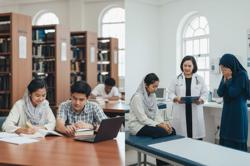IT’S NOT called the dumb cane for nothing. In the days of slavery, plantation owners would pour its sap into the mouths of those who dared to disobey.
The tongues of the sorry serfs would turn turgid, rendering them speechless.
The latest story about the dumb cane, however, is over its daft use, as seen at the Air Keroh Recreational Forest in Malacca €“ now rebranded as Taman Botanikal (Botanical Park).
The undergrowth of this lowland rainforest reserve along the existing jogging track, is being cleared and replanted with rows of dumb cane and other such ornamental plants.
The planting of shrubs is part of the project that covers landscaped areas and a book village (one big building, actually).
The inner forest area, comprising 39ha that had remained largely untouched by humans until recently, is where 32,000 saplings of various timber species and fruit trees, would be planted, reportedly at a cost of RM1.5mil.
Over the past few weeks, workers have been busy marking trails with pink raffia strings before slashing their way in and clearing the topsoil to plant the new trees.
This callous rape of a natural haven doesn’t make any sense, unless some people somewhere are raking in a lot of ringgit in the process.
Why plant trees in a thriving forest when there is a dire need for them in so many places? A suitable area to begin would be along the newly-created buildings surrounding the Malacca International Trade Centre nearby.
Is there a necessity for a botanical park featuring ornamental home and garden plants when both locals and tourists can walk into a natural mixed dipterocarp jungle so near the historical city?
Okay, maybe the book village may not be not such a barmy plan, although I have still not seen that many people there in spite of it having some 15,000 titles and a wifi-enabled reading area.
The raised walkways linking the place to the entrance are functional too, but why should there be rows upon rows of potted plants and a stall hawking orchids in a place meant to be a public park?
But the thing that really gets one’s goat is the ugly, phony waterfall.
When it gets dark, multi-hued bulbs light up the gross contraption. The lights could have been added in a desperate attempt to make it look better but does anyone go there at night to see it?
The rebranded botanical garden is a classic example of taxpayers’ money being continually wasted on hare-brained ideas.
Such projects give new meaning to the term “creative destruction”.
There was nothing fundamentally wrong with the original recreational forest opened to the public in 1984, except for the unmaintained exercise parcourse and public toilets and the lack of access to the canopy walkway.
It was, and still is, a good place for people to appreciate the country’s biodiversity in a relatively safe and convenient place.
Malaysia’s environmental image abroad may be sullied as a result of the anti-palm oil lobbyists, but it remains one of the world’s 17 “megadiversity” countries housing some 60% of the world’s known species of flora and fauna.
As such, officials in charge of nature-related projects must be sensitive to the fact that conservation of plant diversity is fundamental to the preservation of other species as well as the surrounding eco-system.
Air Keroh is a classic example of such insensitivity and short-sightedness. A large part of it has already been cut down to make way for a National Service camp.
In the 80s and 90s, the forest was home to wild boar, gibbons, dusky-leaf monkeys, long-tailed macaques and their piq-tailed cousins. Today only the long-tailed macaques can still be seen; and their numbers, too, have dwindled.
If tourism is indeed the main factor for the re-branding, the forest reserve’s own interesting history can also be a draw.
H.N. Ridley, the man who initiated colonial Malaya’s fledgling rubber industry, was instrumental in designating Air Keroh-Bukit Beruang as a forest reserve, along with selected forests in the other then Straits Settlements €“ Singapore, Penang and Dindings.
Ridley, the first director of the Singapore Botanic Gardens in 1888, was reputedly so concerned about not harming trees that in the case of rubber, he took pains to devise the method to tap bark systematically, without damaging the tree.
Tan Chay Yan, a young man in his 20s from Malacca, was among those who looked up to Ridley. He brought back nine seedlings from Singapore and set up the country’s first rubber plantation in Bukit Lintang. The riches from the new crop turned Tan into a philanthropist but he died young, at 46, from malaria.
Although much damage has been done in Air Keroh, all is still not lost yet, provided there is better coordination among the Plantation Industries and Commodities Ministry, Tourism Ministry and the various Federal and state government departments involved.
The biggest burden of responsibility, however, lies on Perbadanan Hang Tuah Jaya, a recently formed state corporation undertaking integrated development of 16,242ha of land spread over three districts.
Its officers shouldn’t be people who can’t see the forest for the trees.





























